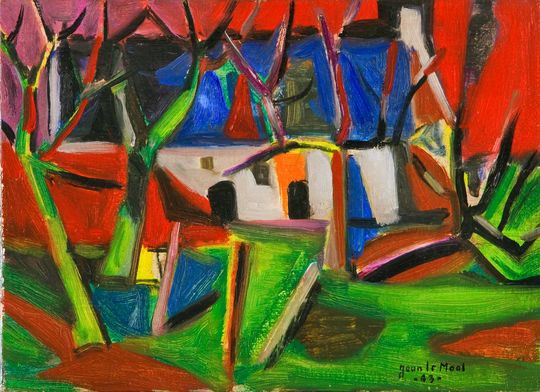Landscape the farm
1943

Oil on canvas
2012-3-1
Purchased in the Art trade in Paris in 2012
H.24 cm - L. 35 cm
Discovering this landscape of farm of 1943 by Jean Le Moal, is coming back to the foundations of his painting and what led him to paint works like The Ocean or Homage to Chardin.
During the Occupation, in 1941, the artist participated in the exhibition of the Twenty young painters of French tradition, in resistance to the Entartete Kunst of the Nazis. To escape to the compulsory labor service, he spent a time at Vannes (Brittany), at his father's. This stay is decisive: he devotes himself entirely to painting.
Le Moal creates an architectural and fragmented space with intense chromaticism in which one can feel the contributions of Cubist and Fauve revolutions. A few realistic elements still structure the work . The vertical and oblique lines that retain the colors remind of the art of stained glass in which Le Moal excels throughout his artistic career. Four years later, Le Moal shifts to non-figuration, retaining only the rhythm of the visible, without falling into pure abstraction.
Landscape the farm
1943

Oil on canvas
2012-3-1
Purchased in the Art trade in Paris in 2012
H.24 cm - L. 35 cm
Discovering this landscape of farm of 1943 by Jean Le Moal, is coming back to the foundations of his painting and what led him to paint works like The Ocean or Homage to Chardin.
During the Occupation, in 1941, the artist participated in the exhibition of the Twenty young painters of French tradition, in resistance to the Entartete Kunst of the Nazis. To escape to the compulsory labor service, he spent a time at Vannes (Brittany), at his father's. This stay is decisive: he devotes himself entirely to painting.
Le Moal creates an architectural and fragmented space with intense chromaticism in which one can feel the contributions of Cubist and Fauve revolutions. A few realistic elements still structure the work . The vertical and oblique lines that retain the colors remind of the art of stained glass in which Le Moal excels throughout his artistic career. Four years later, Le Moal shifts to non-figuration, retaining only the rhythm of the visible, without falling into pure abstraction.
